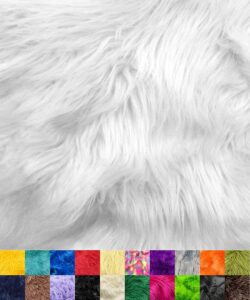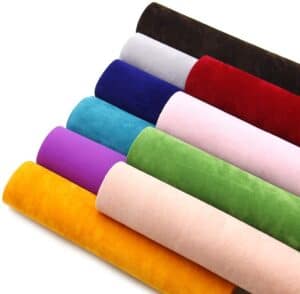Stuffed animals make incredible toys for kids and have a significant impact on their development. They can take multiple roles, from being a play companion to the comforter that lulls them to sleep.
But what makes stuffed animals truly likable and special is their cuddly feel that is delightful to the skin senses. Therefore, if you are thinking of sewing up a few, your choice of fabric is vital as it should reflect this quality and more.
What is the best fabric for stuffed animals? The best fabric for stuffed animals is soft plush and durable fabric like Minky and fleece. Cotton and felt are also popular traditional choices precisely for adding colorful accents.
Stick around and learn more about the various types of fabrics you can use for stuffed animals. We also provide a helpful buying guide to enable you to choose the most appropriate material for your project.
Choosing Fabric For Stuffed Animals
Cute stuffed animals are attractive, but the prettiest fabric isn’t always the best for making these stuffie friends. Other critical features make one fabric better suited for the task than another. Here’s what to look for when sampling fabrics for stuffed animals.
1. Safety
Parents are always looking to create safe havens for their kids. Therefore, safety is the number one priority when purchasing stuffed animals to fill the nursery or room.
Older kids tend to hug and even sleep with them, so they are in constant physical contact. It is not uncommon to find babies and toddlers putting stuffed toys in their mouths as well; another reason safety ranks first.
Safety begins from the naturalness of the fabric to any dyes and chemicals used. Natural materials have always been prioritized for kids, but there are plenty of comfortable synthetic fabrics for such projects too.
If you opt for 100% natural fabrics, they should preferably be GOTS or OEKO-Tex certified. It is the ultimate assurance that the fibers are processed with the highest safety and purity standards.
You also want to consider any sensitivities by choosing hypoallergenic fabrics. Remember, natural material isn’t always hypoallergenic. Wool, for example, is associated with allergies, while Polyester, a synthetic fabric, is hypoallergenic.
2. Durability
The durability of the fabric is a crucial aspect when making stuffed animals. One, because we are sure you want to craft products that last, and two, because they go through many kiddie adventures and are vulnerable to dirt and wear pretty quickly.
You know how kids put them on the floor, drag them around everywhere, and even become the center of tag and war. Sometimes, the little stuffed guests get food and drink spills and stains.
Consequently, the fabric should be tough enough to withstand tension and abrasion of playtime and many wash cycles in its lifetime, whether by hand or machine.
It would be best if the fabric is machine washable and can go through tumble drying. Considering how dirty they can get, it is a hassle-free method of keeping them clean and avoiding mold and mildew inside from not drying properly.
3. Texture
Check that the fabric is soft on delicate skin and not scratchy. It could be a pleasant velvety, fuzzy, or fluffy feeling, usually from the pile profile.
Fluffier fabrics tend to harbor more dust and mites, so you also want to check on that for anyone with allergic rhinitis and related conditions.
Extra-long fluff is always disapproved of stuffed animals meant for babies. They tend to put things in their mouths, and such fabrics do shed hair. However, they make beautiful stuffed animals for adults and room centerpieces.
Best Fabrics For Stuffed Animals
You probably now have an idea of the kind of fabric you want for your stuffed animals. To help get you much closer to the best one for your project, here are our 7 best picks.
1. Minky
See Suggested Product on Amazon
Minky is a tight-knit fabric made from 100% polyester with plush on one side. It is loved for its ultra-softness and thickness, eliminating the need for batting.
Being a knit fabric, minky is two or four-way stretchy but holds shape well. When stuffed, it produces perfectly structured seams.
It may be challenging for beginners to sew because of the stretch, and you must use a jersey needle to sail smoothly. Once you get the hang of it, it is among the best plush fabrics for stuffed animals.
Today minky is available in many solid colors and pile lengths.
2. Fleece
See Suggested Product on Amazon
Fleece is the affordable alternative to minky. It is equally soft and tight-knit and is made from polyester.
The fabric is very famous for its warmth and cozy feel. We are sure you must have come across its throw pillow covers, blankets, and sweaters.
Well, it is versatile enough for a variety of other projects, including stuffed animals. It is reasonably stretchy and creates structured forms well.
The price range for fleece is vast, but if you go too low, you might risk buying the inferior quality kind of fleece that pills badly over time.
3. Cotton
See Suggested Product on Amazon
When you think of natural tough fabrics, cotton is the most likely to come to mind. Though its smoothness is acceptable, it is not as silky soft as engineered fabrics like minky and fleece.
But that’s no deal-breaker. Despite the slight crisp in texture, cotton remains loved for its many other outstanding qualities. It is natural and hypoallergenic and is suitable for kids’ sensitive skin.
Cotton is not fussy in high heat and wetness. Its fibers remain resilient and are highly durable. It does not shed or pill even after consistent machine laundering.
The fabric is resistant to the growth of mold and mildew and doesn’t harbor dust mites. It has a little stretch but is reasonably easy to sew. However, it must be tightly packed to achieve smooth seams and structure.
Cotton flannel and quilting cotton are typical choices too. They are especially good for lining the inner surface of the ears, hands, and feet of stuffed animals.
These are available in beautiful prints that can dramatically twist the design or convey a particular theme.
4. Felt
See Suggested Product on Amazon
Felt is an inexpensive fabric that is good for newbies making stuffed animals for the first time without spending too much. It has no grain and, therefore, can be cut in whichever direction saving fabric.
There are different types of felt made from natural, synthetic, or a blend of fibers. Depending on the fibers, it can be pretty stiff or soft. For stuffed animals, opt for the latter.
While nothing stops you from choosing felt as the primary fabric, it works best for accents, bringing forth texture and character to stuffed animals.
5. Faux Fur
See Suggested Product on Amazon
Faux fur is the perfect choice for fuzzy stuffed animals like shaggy dogs or the mane of horses, unicorns, and lions. It is usually made from synthetic fibers such as acrylic and polyester to mimic real fur, only in countless color options.
This fabric has a long pile of 2 inches or more. Consequently, faux fur is not ideal for baby toys as the hairs are a choking hazard. But would be perfect for older kids, adults, and decorative stuffed animals.
Good quality faux fur is soft, fluffy, and doesn’t mat. It is best washed by hand or in a delicate cold cycle.
Although it leaves a big mess when cut and is tricky to sew for beginners, it is the best fabric for hiding your inexperience. Any flaws of the seam remain hidden between the long hairs.
6. Velboa Skin
See Suggested Product on Amazon
If you want a safer faux fur alternative for infants’ stuffed animals, velboa skin is your best bet. Velboa is a low pile faux fur made from polyester to resemble furry animal coats.
The fabric isn’t anything like the previously discussed faux fur. It has a low super soft nap that is kind of realistic. Velboa is made from tough polyester that is durable and hypoallergenic, which are perfect features for stuffed animals.
It is available in plenty of assorted colors and fun animal prints like tiger, giraffe, cheetah, dalmatian, cow, etc.
7. Velvet
See Suggested Product on Amazon
Velvet isn’t one of those fabrics one would normally use on toys. It connotes elegance and luxury so putting it on toys may be somewhat an extravagant move.
Still, its silky smooth feel, coziness, knit base, and stretch make it an exquisite choice for premium stuffed animals. Traditionally, velvet fabric was made from a cotton base, but today synthetic bases like polyester are prevalent.
It consists of a short silky smooth pile that feels heavenly brushing against the skin. It also reflects light at different angles producing a beautiful shimmery gloss.
Sewing velvet isn’t such an uphill task, especially if you go for varieties with some stretch. Those are more forgiving. The care and durability of velvet fabrics depend on the fibers and quality of the velvet weave. It is available in lots of solid colors and prints.
Selecting the best fabric for stuffed animals is a significant part of the project. Yet, the freedom to mix different materials is the most exciting thing about sewing stuffies.
Feel free to use either or a combination of any of the above fabrics or even some of your treasured scraps and just have fun with it.
Up Next: Best Eyes For Stuffed Animals







